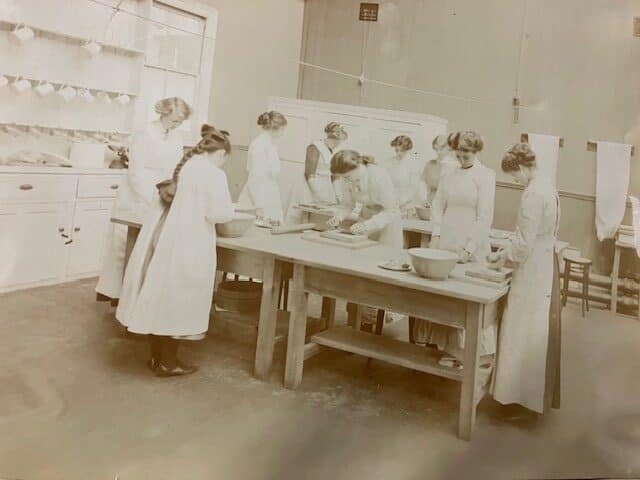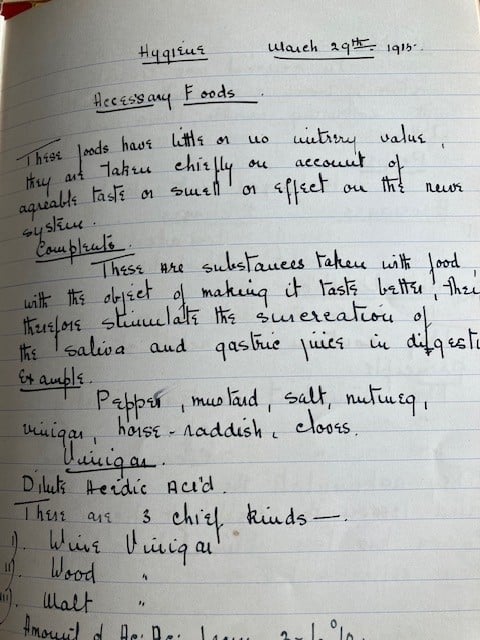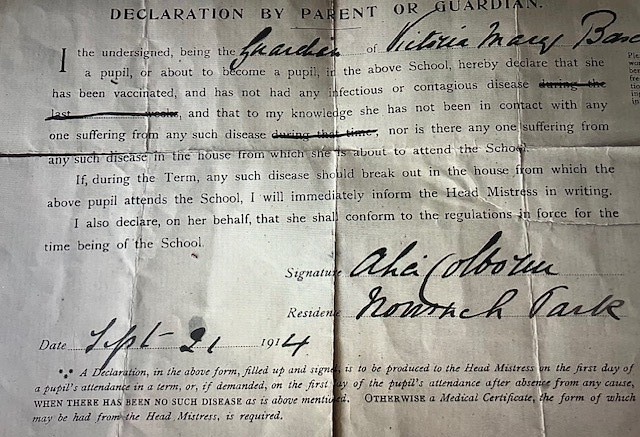School archivist and former head of history Sue James reviews her latest fascinating find…
I refer to our more unique and interesting artefacts in the archive as “treasures”. Most have been in the archive for decades but, occasionally, another one turns up and adds to the knowledge of the history of the school as well as girls’ education in general.
This “treasure” started with an email from a gentleman living in Ashtead who had some of his grandmother’s school exercise books from 1914-1915. He wondered whether I would have a use for them and I was immediately interested. The archive has a number of artefacts from the Great War which show us a great deal about what life was like for students during this cataclysmic era but no exercise books. Secondly, this alumna, called Victoria Mary Kate Caroline Baxter, known as May, came to the school to do the Domestic Science course at age 15. This was a course set up in 1911 by the then headmistress, Miss Bell, to give older students the opportunity to take examined courses in homecraft and nursing skills. There was a practical element to these courses but also an emphasis on the science of the topics and this was a popular innovation in the education of middle-class girls. The classes were held on the first floor of Fernwood, a villa which was across the road from the main part of the school and was mainly the domain of the kindergarten.
Picture of Fernwood cooking taken from the log-book

The content of the exercise books, which are in very good condition, are fascinating. May was taught simple practical “housewifery” chores such as how to patch a hole in a garment to more dangerous tasks including how to nurse someone with diphtheria. Some information would be questioned today; I don’t think we would say that a woman needed only 10% of the amount of food that a man eats! An examination paper slipped into one of the books show how the course combined science with domesticity. Try this question: “Distinguish between true proteids and albummoids. Name the proteids which are coagulated by heat”. Notice also the neatness of May’s handwriting.

Picture of exercise book
So, where is the mystery in this? May Baxter was born in London, the daughter of a bank clerk who, according to May’s daughter, Pam, and a newspaper account, was an alcoholic. May’s mother died in 1904 when May was seven and, this is where the mystery starts. May was fostered out to the Rose family whose father worked as a labourer on the Nonsuch estate; they lived in one of the white weather-boarded cottages opposite the entrance to the park on the Ewell Road. Why May came all the way to Cheam was not known by any of the family but, according to Pam, this was a happy household and May remained close to this family throughout their lives. However, the Roses were working people who would not have had the funds to send a foster daughter to our school. In fact, they had a biological daughter who was the same age as May and she left school at a young age to work on the estate.
So, where did the money come from to send May to our school? The school’s admissions register records May’s father as “believed deceased” but a document that came with the exercise books is signed by May’s guardian, the Honourable Alice Colborne, the owner of Nonsuch Park. This document is interesting in itself; dated September 1914, it is a declaration that May has been vaccinated and has not suffered from or been in contact with, an infectious disease. Why, though, did May’s guardian give her this head-start in life? Perhaps it was just a philanthropic gesture to a promising student of the Cheam Girls’ School, who, according to the local newspaper, had won prizes for her needlework skills. Perhaps Alice felt that May would have been better educated if she had lived with her birth family, which is probably true. Alice herself was childless so perhaps that is why she took an interest in a girl on the Nonsuch estate. There are so many scenarios but we will never know as no reason was given. One thing we do know, however, is that the owners of Nonsuch Park had a connection with the school from its early years and that Alice handed out the prizes in 1913. Had she spoken to Miss Bell about May on this or other occasions? Perhaps.
Whatever the reason, the two years that May spent at Fernwood enabled her to secure a nursing certificate and then, presumably with her connection to Alice, to get a position as a children’s nurse to an aristocratic family in London. This elevated May’s status in society and meant she did not have to enter domestic service or work on the Nonsuch estate like her foster sister.

Picture of Declaration
When the Jubilee book of the school came out in 1934 it included a list of past alumnae with details of what had happened to them after they left school. There was only a mention of May’s name and the dates she went to the school so it would appear that May had not kept in touch. I wonder what she would have felt if she knew that 110 years after she arrived at Sutton High, her exercise books would become a treasure of the archive. If only she was alive to help solve the mystery of why she came here in the first place.
With thanks to Pamela and Christopher Blunt for the exercise books but for also enlightening us about May’s life and her time at Sutton High.
Sue James, archivist
